 Technology peripherals
Technology peripherals
 AI
AI
 GNNs technology applied to recommendation systems and its practical applications
GNNs technology applied to recommendation systems and its practical applications
GNNs technology applied to recommendation systems and its practical applications

1. The evolution of underlying computing power of GNNs recommendation system
In the past 20 years, computing forms have continued to evolve. Before 2010, cloud computing was particularly popular, while other computing forms were relatively weak. With the rapid development of hardware computing power and the introduction of end-side chips, edge computing has become particularly important. The current two major computing forms have shaped the development of AI in two polarized directions. On the one hand, under the cloud computing architecture, we can use ultra-large-scale cluster capabilities to train large-scale AI models, such as Foundation Model or some generative models. On the other hand, with the development of edge computing, we can also deploy AI models to the terminal side to provide more lightweight services, such as performing various recognition tasks on the terminal side. At the same time, with the development of the metaverse, the calculations of many models will be placed on the end side. Therefore, the core issue that these two computing forms want to reconcile is the balance between computing and transmission, followed by the polarized development of artificial intelligence.
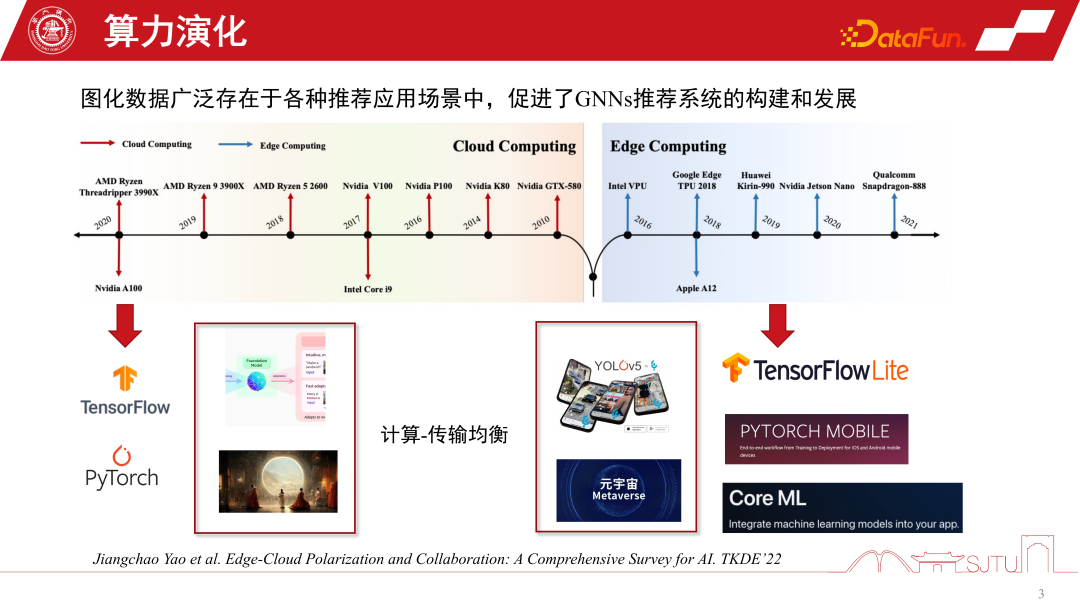
2. Personalization of end-side GNNs recommendation system

These two calculations What opportunities does form bring to GNNs recommendation systems?
Duanyun’s perspective can be compared to the perspective of a global picture and a localized subgraph. In the recommendation system of GNNs, the global subgraph is a global subgraph that is continuously gathered from many node-level subgraphs. Its advantage is that the data is complete and it can provide a relatively comprehensive relationship between nodes. This kind of inductive bias may be more universal. It summarizes the rules of various nodes and extracts the inductive bias, so it has strong generalization ability. The localized subgraph is not necessarily particularly complete, but its advantage is that it can accurately describe the evolution of an individual's behavior on the subgraph and provide personalized node relationship establishment. Therefore, the relationship between the terminal and the cloud is a bit like a global subgraph and a localized subgraph. Cloud computing can provide powerful centralized computing power to provide services, while the terminal can provide some data personalized services
We can combine the advantages of the global graph and localized subgraphs to To better improve the performance of the model, a study published in WSDM2022 this year explored this. It proposes an Ada-GNN (Adapting to Local Patterns for improving Graph Neural Networks) model, which has an entire graph modeling for the global graph, and also builds some local models using subgraphs to do some adaptation. The essence of such adaptation is to allow the model that combines the global model and the local model to perceive the rules of the local graph in a more refined manner and improve personalized learning performance.

Now we use a specific example to explain why we should pay attention to subgraphs. In the e-commerce recommendation system, there is a group of digital enthusiasts who can describe the relationship between digital products, such as mobile phones, Pads, cameras and mobile phone peripheral products. Once he clicked on one of the cameras, an inductive bias was induced. An inductive bias map induced by the group contribution map may encourage us to recommend this kind of mobile phone, but if we return to the individual perspective, if he is a photography enthusiast and pays special attention to photography products, this will sometimes result The paradox shown below. Is the inductive bias induced by the group contribution map too strong for certain groups, especially this tail group? This is what we often call the Matthew effect.
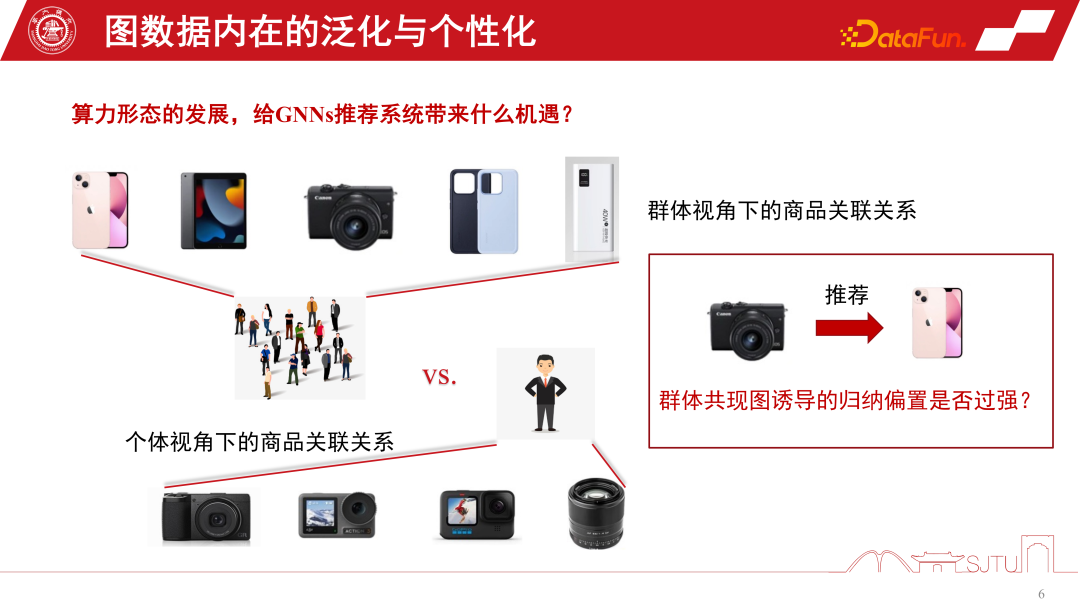
In general, the existing polarized computing forms can reshape our modeling of GNNs recommendation systems. Traditional recommendation systems recall products or items from a candidate pool, perceive the relationship between them through GNNs modeling, and then rank and recommend users. However, due to the support of edge computing, we can deploy personalization models on the end side to perceive more fine-grained personalization by learning on subgraphs. Of course, this new recommendation system architecture for device-cloud collaboration has an assumption, that is, the computing power and power consumption of the device are feasible. But the actual situation is that the computing power overhead of a small model is not large. If you compress it to one or two megabytes and put the computing overhead on an existing smartphone, it will not actually consume more computing power than a game APP. and large electrical energy. Therefore, with the further development of edge computing and the improvement of end device performance, it provides greater possibilities for more GNNs modeling on the end side
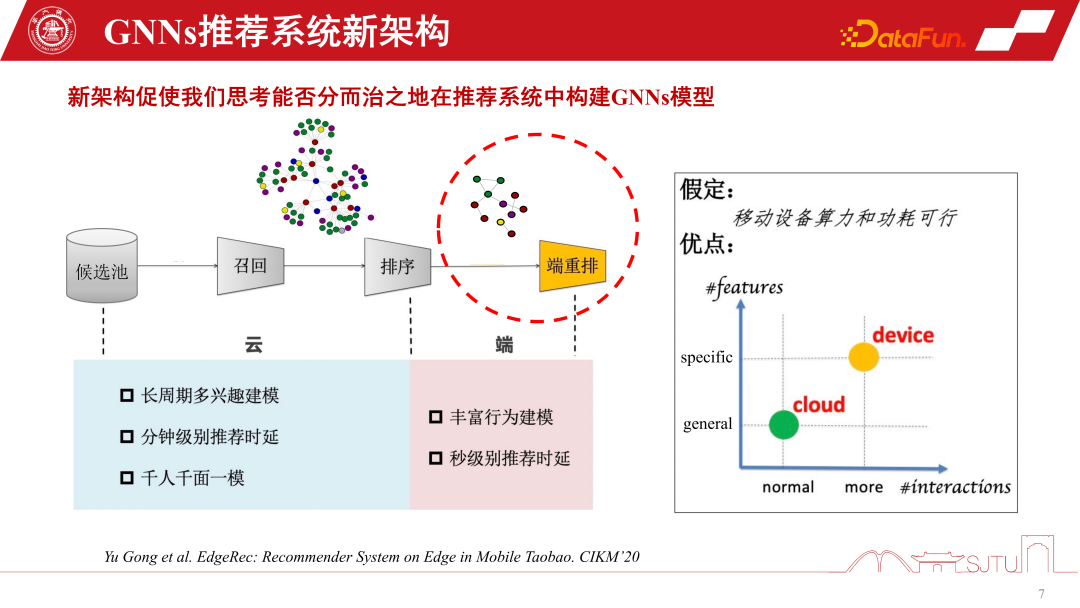
If we want to put the GNNs model on the terminal, we must consider the computing power and storage capacity of the terminal. We also mentioned model compression earlier. If you want the GNNs model to be more effective on the device side, if you put a relatively large GNNs model on it, you must perform model compression. The traditional methods of model compression, pruning and quantization, can be used on existing GNNs models, but they will cause performance losses in recommendation systems. In this scenario, we cannot sacrifice performance in order to build a device-side model, so although pruning and quantization are useful, they have limited effect.
Another useful model compression method is distillation. Although it may only be reduced by several times, the cost is similar. A recent study published in KDD is about the distillation of GNNs. In GNNs, distillation of graphical data modeling faces a challenge that distance measures are easily defined in logit space, but in latent feature space, especially layer-by-layer distance measures between teacher GNNs and student GNNs. In this regard, this research on KDD provides a solution to achieve learnable design by learning a metric through adversarial generation
In GNNs recommendation system, in addition to the previous The model compression technique mentioned, split deployment is a specific and very useful technique. It is closely related to the model architecture of GNNs recommendation system, because the bottom layer of GNNs is the Item Embedding of the product, and after several layers of MLP non-linear transformation, the aggregation strategy of GNNs is used
Once a model is trained, it has a natural advantage. The base layer is all shared, and only the GNNs layer can be customized. For personalization here, we can split the model into two parts and put the public part of the model in the cloud. Because the computing power is sufficient, the personalized part can be deployed on the terminal. In this way, we only need to store the GNN of the intermediate kernel in the terminal. In actual recommendation systems, this approach can greatly save the storage overhead of the entire model. We have practiced in Alibaba's scenarios. The model after split deployment may reach the KB level. Then through further simple bit quantization model, the model can be made very small, and there is almost no particularly large overhead when placed on the terminal. Of course, this is a split method based on experience. One of Huawei's recent work published on KDD is automatic model splitting, which can sense the performance of terminal equipment and automatically split this model. Of course, if applied to GNNs, some reshaping may be required

When deploying the model in some serious distribution transfer scenarios, our Pre-trained models are relatively old before they are deployed on the device. This is because the frequency of actual graph data flowing back to the cloud for training is relatively slow, and sometimes it may take a week.
The main bottleneck here isResource constraints, although you may not necessarily encounter this bottleneck in research, in practice you will encounter the problem of outdated end-side models. As the domain changes, the data changes, the model is no longer applicable, and performance will decline. At this time, online personalization of the GNNs model is needed, but personalization on the end will face the challenge of end-side computing power and storage overhead.
Another challenge is data sparseness. Because the end data only has individual nodes, its data sparsity is also a big challenge. Recent research has a relatively efficient approach, which is Parameter-Efficient Transfer. Applying some model patches between layers can be compared to the residual network, but you only need to learn the patches when learning. Through a flag mechanism, it can be turned on when in use and turned off when not in use. When turned off, it can be degraded to the original basic model, which is both safe and efficient.
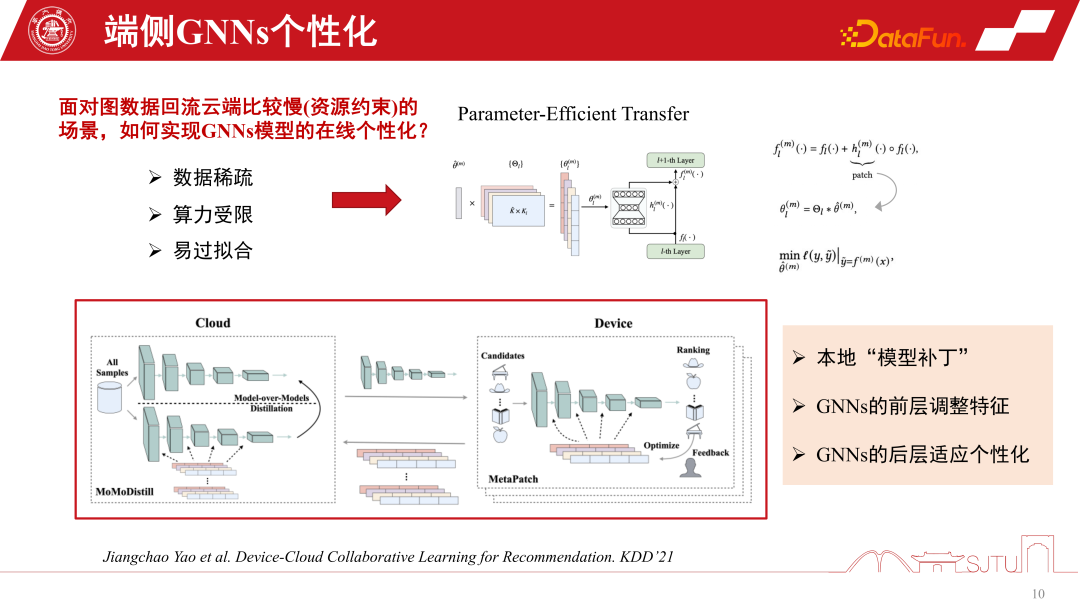
This is a more practical and efficient approach, published on KDD2021, which can achieve online personalization of GNNs models. The most important thing is that we discovered from such a practice that by sensing the subgraph information of this local model, the overall performance can indeed be steadily improved. It also alleviates the Matthew effect.
In the recommendation system, tail users still face the problem of the Matthew effect on graph data. However, if we adopt a divide-and-conquer modeling approach and personalize subgraphs, we can improve the recommendation experience for users with sparse behaviors. Especially for the tail crowd, the performance improvement will be more significant
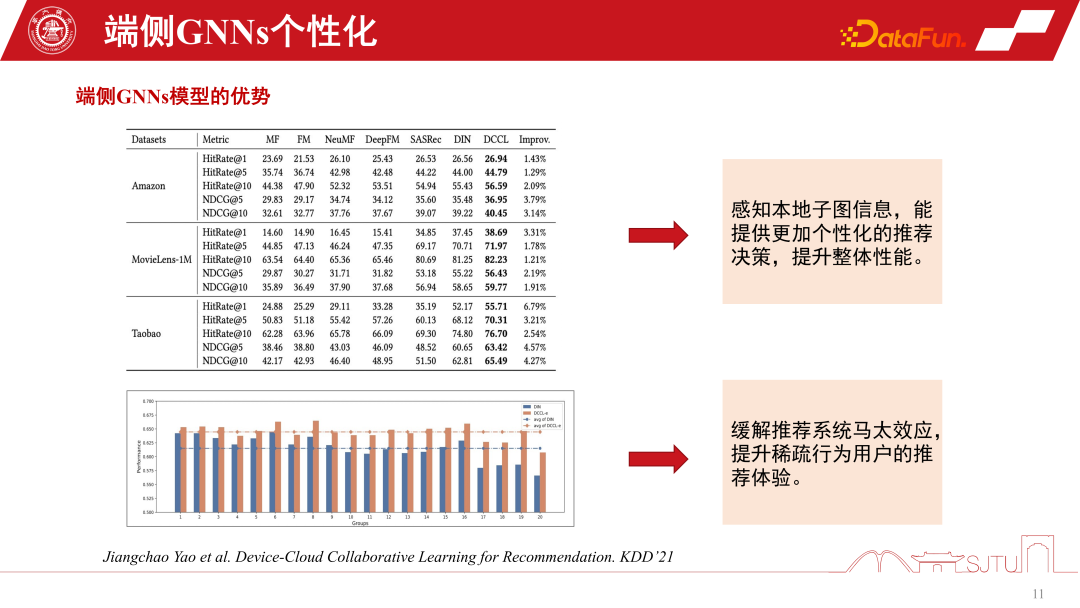
3. Implementation of terminal-cloud collaborative GNNs recommendation system
In the GNNs recommendation system, there is a GNNs model for cloud-side services and a small model of GNNs for the client side. There are three implementation forms of GNNs recommendation system services. The first is session recommendation, which is a common batch session recommendation in recommendation systems to save costs. That is, batch recommendations are made at one time and require users to browse many products before the recommendation will be triggered again. The second is to recommend only one at a time in extreme cases. The third type is the end-to-end personalized model we mentioned. Each of these three recommendation system methods has its own advantages. When user interests change slowly, we only need the cloud side to perceive it accurately, so it is enough for the cloud side model to do session recommendation. When user interests change more and more diversely, personalized recommendation of end-side subgraphs can relatively improve recommendation performance.
In situations where user behavior suddenly becomes very sparse, recommendations rely more on common sense reasoning. In order to coordinate these three recommendation behaviors, a meta coordinator - Meta Controller can be established to coordinate the GNNs recommendation system
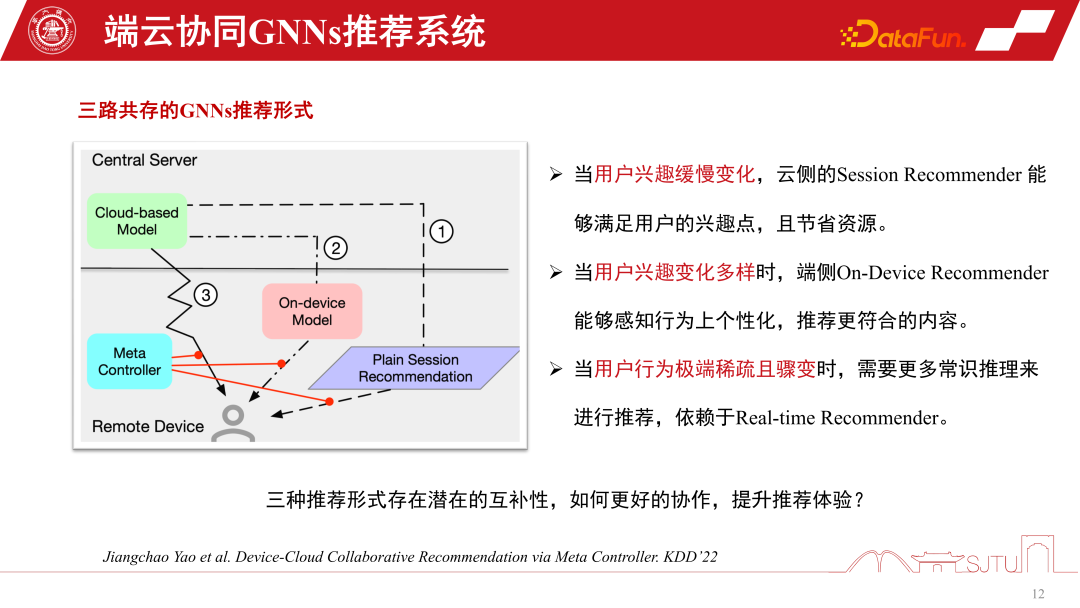
Construct a three-way coexistence end-cloud One challenge of collaborative recommendation systems is the construction of data sets, because we don’t know how to manage these models and how to make decisions. So this is just a counterfactual reasoning mechanism. Although we do not have such a data set, we do have a single-channel data set, and we construct some proxy models through evaluation to evaluate their causal effects. If the causal effect is relatively large, then the benefits of making such a decision will be relatively large, and pseudo labels, that is, counterfactual data sets, can be constructed. The specific steps are as follows:
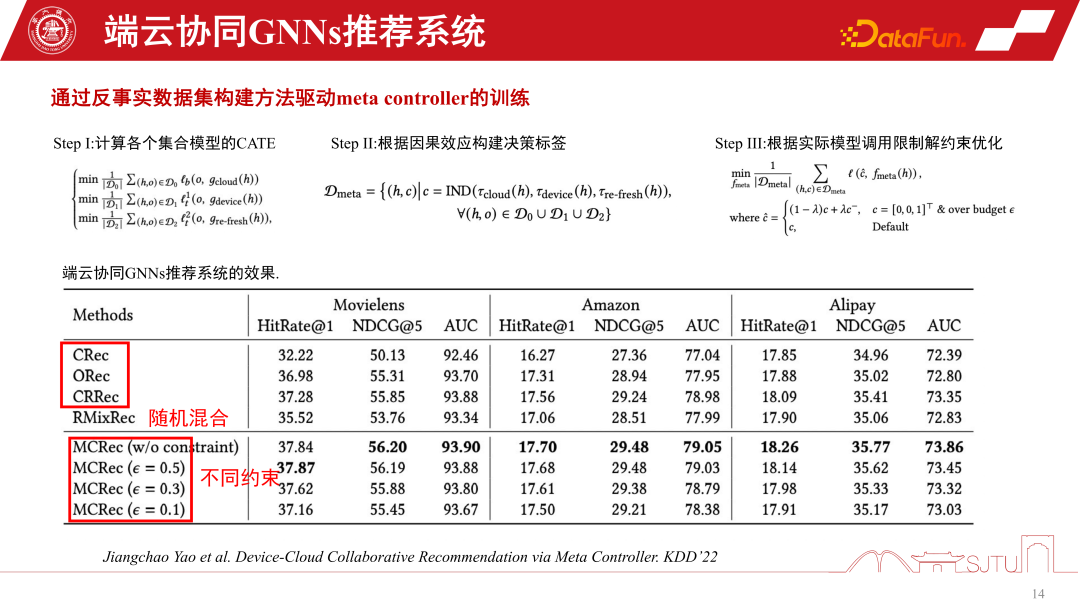
There are three models D0, D1, and D2 in a single channel. By learning the causal model of an agent, their causal effects are estimated. Construct a decision label and construct a counterfactual dataset to train the meta-coordinator. Finally, we can prove that this meta-coordinator has a stable performance improvement compared to each single-channel model. It has significant advantages over random heuristics. We can construct a recommendation system for device-cloud collaboration in this way.
4. Security Issues of the End-Side GNNs Recommendation System
Finally, let’s discuss the security issues of the end-side GNNs recommendation system. Once the device-cloud collaborative GNNs recommendation system is opened for use, it will inevitably face problems in the open environment. Because the model needs to be personalized for learning, there will be some risks of attacks, such as escape attacks, poisoning attacks, backdoor attacks, etc., which may ultimately cause the recommendation system to face huge security risks
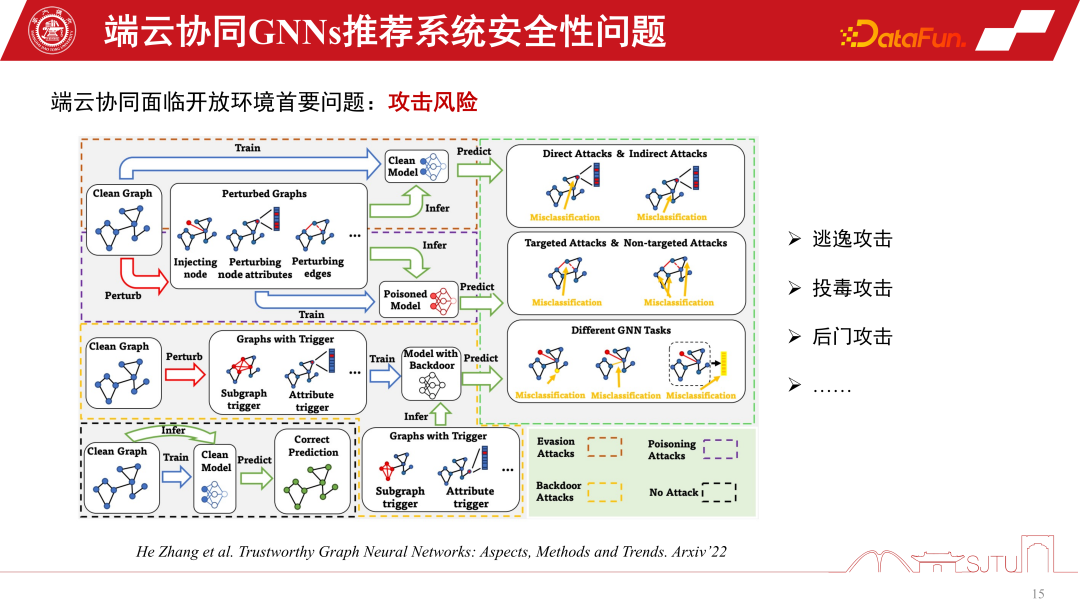
The underlying computing power drives the direction of the current-end cloud collaborative GNNs recommendation system, but it is still in the early stages of development and there are some potential problems, such as security issues. At the same time, in personalized model building There is still a lot of room for improvement in the field of modeling.
5. Question and Answer Session
Q1: When building a graph model on the terminal, will the traffic of subgraphs be distributed too much?
A1: The sub-picture is not distributed, it is actually aggregated. The first point is that sub-pictures are distributed in an accompanying manner. For example, when we want to recommend products, it will naturally carry attribute information of the products. The issuance of companion style here has the same level of overhead as attributes. In fact, the overhead is not very high. Because it does not deliver the entire big picture, but only some neighbor subgraphs. At most, the second-order neighbor subgraphs are still very small. The second point is that some sub-graphs on the end are automatically constructed based on some co-occurrence and clicks based on feedback from user behavior, so it is a form of double-end aggregation and the overall cost is not particularly large.
The above is the detailed content of GNNs technology applied to recommendation systems and its practical applications. For more information, please follow other related articles on the PHP Chinese website!

Hot AI Tools

Undresser.AI Undress
AI-powered app for creating realistic nude photos

AI Clothes Remover
Online AI tool for removing clothes from photos.

Undress AI Tool
Undress images for free

Clothoff.io
AI clothes remover

Video Face Swap
Swap faces in any video effortlessly with our completely free AI face swap tool!

Hot Article

Hot Tools

Notepad++7.3.1
Easy-to-use and free code editor

SublimeText3 Chinese version
Chinese version, very easy to use

Zend Studio 13.0.1
Powerful PHP integrated development environment

Dreamweaver CS6
Visual web development tools

SublimeText3 Mac version
God-level code editing software (SublimeText3)

Hot Topics
 How to implement a recommendation system using Go language and Redis
Oct 27, 2023 pm 12:54 PM
How to implement a recommendation system using Go language and Redis
Oct 27, 2023 pm 12:54 PM
How to use Go language and Redis to implement a recommendation system. The recommendation system is an important part of the modern Internet platform. It helps users discover and obtain information of interest. The Go language and Redis are two very popular tools that can play an important role in the process of implementing recommendation systems. This article will introduce how to use Go language and Redis to implement a simple recommendation system, and provide specific code examples. Redis is an open source in-memory database that provides a key-value pair storage interface and supports a variety of data
 Recommendation system algorithms and applications implemented in Java
Jun 19, 2023 am 09:06 AM
Recommendation system algorithms and applications implemented in Java
Jun 19, 2023 am 09:06 AM
With the continuous development and popularization of Internet technology, recommendation systems, as an important information filtering technology, are increasingly being widely used and paid attention to. In terms of implementing recommendation system algorithms, Java, as a fast and reliable programming language, has been widely used. This article will introduce the recommendation system algorithms and applications implemented in Java, and focus on three common recommendation system algorithms: user-based collaborative filtering algorithm, item-based collaborative filtering algorithm and content-based recommendation algorithm. User-based collaborative filtering algorithm is based on user-based collaborative filtering
 Application example: Use go-micro to build a microservice recommendation system
Jun 18, 2023 pm 12:43 PM
Application example: Use go-micro to build a microservice recommendation system
Jun 18, 2023 pm 12:43 PM
With the popularity of Internet applications, microservice architecture has become a popular architecture method. Among them, the key to the microservice architecture is to split the application into different services and communicate through RPC to achieve a loosely coupled service architecture. In this article, we will introduce how to use go-micro to build a microservice recommendation system based on actual cases. 1. What is a microservice recommendation system? A microservice recommendation system is a recommendation system based on microservice architecture. It integrates different modules in the recommendation system (such as feature engineering, classification
 The Secret of Accurate Recommendation: Detailed Explanation of Alibaba's Decoupled Domain Adaptation Unbiased Recall Model
Jun 05, 2023 am 08:55 AM
The Secret of Accurate Recommendation: Detailed Explanation of Alibaba's Decoupled Domain Adaptation Unbiased Recall Model
Jun 05, 2023 am 08:55 AM
1. Scenario introduction First, let’s introduce the scenario involved in this article—the “good goods are available” scenario. Its location is in the four-square grid on Taobao's homepage, which is divided into a one-hop selection page and a two-hop acceptance page. There are two main forms of acceptance pages, one is the image and text acceptance page, and the other is the short video acceptance page. The goal of this scenario is mainly to provide users with satisfactory goods and drive the growth of GMV, thereby further leveraging the supply of experts. 2. What is popularity bias, and why next we enter the focus of this article, popularity bias. What is popularity bias? Why does popularity bias occur? 1. What is popularity bias? Popularity bias has many aliases, such as Matthew effect and information cocoon room. Intuitively speaking, it is a carnival of high-explosive products. The more popular the product, the easier it is to be exposed. This will result in
 How does Go language implement cloud search and recommendation systems?
May 16, 2023 pm 11:21 PM
How does Go language implement cloud search and recommendation systems?
May 16, 2023 pm 11:21 PM
With the continuous development and popularization of cloud computing technology, cloud search and recommendation systems are becoming more and more popular. In response to this demand, the Go language also provides a good solution. In the Go language, we can use its high-speed concurrent processing capabilities and rich standard libraries to implement an efficient cloud search and recommendation system. The following will introduce how the Go language implements such a system. 1. Search on the cloud First, we need to understand the posture and principles of search. Search posture refers to the search engine matching pages based on the keywords entered by the user.
 Recommendation system for NetEase Cloud Music cold start technology
Nov 14, 2023 am 08:14 AM
Recommendation system for NetEase Cloud Music cold start technology
Nov 14, 2023 am 08:14 AM
1. Problem background: The necessity and importance of cold start modeling. As a content platform, Cloud Music has a large amount of new content online every day. Although the amount of new content on the cloud music platform is relatively small compared to other platforms such as short videos, the actual amount may far exceed everyone's imagination. At the same time, music content is significantly different from short videos, news, and product recommendations. The life cycle of music spans extremely long periods of time, often measured in years. Some songs may explode after being dormant for months or years, and classic songs may still have strong vitality even after more than ten years. Therefore, for the recommendation system of music platforms, it is more important to discover unpopular and long-tail high-quality content and recommend them to the right users than to recommend other categories.
 Application of cause-and-effect correction method in Ant Marketing recommendation scenario
Jan 13, 2024 pm 12:15 PM
Application of cause-and-effect correction method in Ant Marketing recommendation scenario
Jan 13, 2024 pm 12:15 PM
1. Background of cause-and-effect correction 1. Deviation occurs in the recommendation system. The recommendation model is trained by collecting data to recommend appropriate items to users. When users interact with recommended items, the data collected is used to further train the model, forming a closed loop. However, there may be various influencing factors in this closed loop, resulting in errors. The main reason for the error is that most of the data used to train the model is observation data rather than ideal training data, which is affected by factors such as exposure strategy and user selection. The essence of this bias lies in the difference between the expectations of empirical risk estimates and the expectations of true ideal risk estimates. 2. Common biases There are three main types of common biases in recommendation marketing systems: Selective bias: It is due to the user’s root
 Recommendation system and collaborative filtering technology in PHP
May 11, 2023 pm 12:21 PM
Recommendation system and collaborative filtering technology in PHP
May 11, 2023 pm 12:21 PM
With the rapid development of the Internet, recommendation systems have become more and more important. A recommendation system is an algorithm used to predict items of interest to a user. In Internet applications, recommendation systems can provide personalized suggestions and recommendations, thereby improving user satisfaction and conversion rates. PHP is a programming language widely used in web development. This article will explore recommendation systems and collaborative filtering technology in PHP. Principles of recommendation systems Recommendation systems rely on machine learning algorithms and data analysis. It analyzes and predicts user historical behavior.





